Retrieved from https://studentshare.org/finance-accounting/1413398-capital-asset-pricing-model
https://studentshare.org/finance-accounting/1413398-capital-asset-pricing-model.

and Section # of Capital Asset Pricing Model is a tool extensively used to value assets in the financial sector. It has been extensively used in calculating the required return of investment products. The capital asset pricing model was introduced in the 1960s by William Sharpe; since then it has been considered as the cornerstone of predicting the required return on an investment. Required Return: Risk free rate + ? (Average Market Return –Risk free rate) Where ? is the beta value of the financial asset The basic assumptions of this model pose as disadvantageous for this model to be considered as a perfect representative of required return calculation.
One of its basic assumptions is that investors are holding diversified portfolios that are emulating the average market return; implying that the unsystematic risk is eliminated from the risk versus return calculation of the investor. On the whole, investors do try and make diversified portfolios in such a way that it portfolio return complements or exceeds the market return. Therefore, this assumption is not a big concern and is fairly reasonable (Eugene, 2010). Another assumption is that it can only account for single period transition horizon and usually a single year is used for comparison between two securities.
This is another reasonable assumption as investors usually quote returns on an annual basis even if they hold a security for a longer period (Eugene, 2010). The assumption that the average investor can borrow at risk free rate is misleading. The pure reason for this is the difference of lending to a government as compared to an investor; risk is higher when lending to an individual, whereas governments are reasonably safer borrowers. Most of the investors are unable to borrow at the risk free rate, which is another assumption of the equation.
Therefore, in real life, the security market line will be shallow than as depicted by the SML (Scott, 2006). Prevalence of perfectly operating capital market is also a theory based assumption and does not happen in the real world scenario; owing to taxes and transaction costs and unavailability of perfect information to all investors. There is a big probability of many of the securities in a market being ill-priced; therefore, there is no perfect capital market. Compared to the CAPM, dividend valuation model is a different method to reach the same conclusion as the CAPM.
Dividend valuation model assumes that the companies with greater risk will compensate their security holders with higher returns in the form of dividends. The required rate is found out by the summation of the present value of all the future expected cash flows from holding that security. Three different types of DDM ensure that all scenarios are accounted for; for stocks that provide no dividends, for stocks that have a constant dividend growth rate and for those which have a variable rate. The basic assumption in this scenario is that the price of the stock should reflect the intrinsic value of the stock that can be represented by the dividends that it will pay in the future.
This model looks at the price of a security from a completely different angle and includes projections about the company performance and its dividend payout ratio. Any changes in these two will affect the pricing (Eugene, 2010). CAPM and DVM interact with each other as they use the same risk free rate for valuation purposes. BIBLIOGRAPHY Hoover, S. (2006) Stock Valuation: an essential guide to Wall Street’s most popular valuation models. McGraw Hill Professionals Brigham, E., Ehrdhart, M. (2010) Financial Management: theory and practice.
Cengage Learning
Read More
